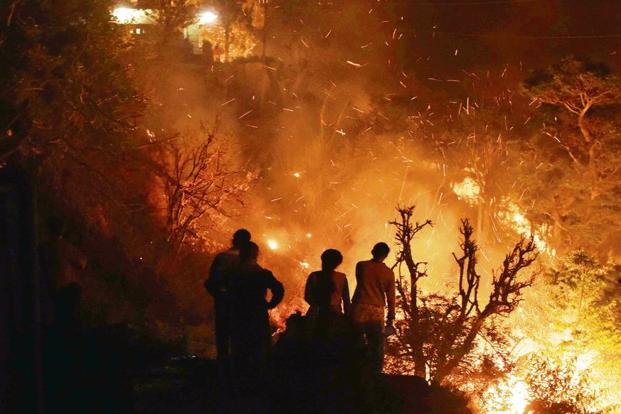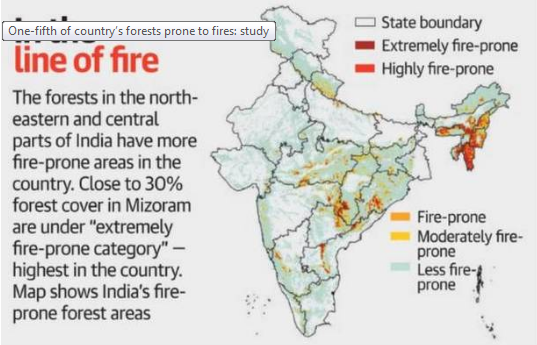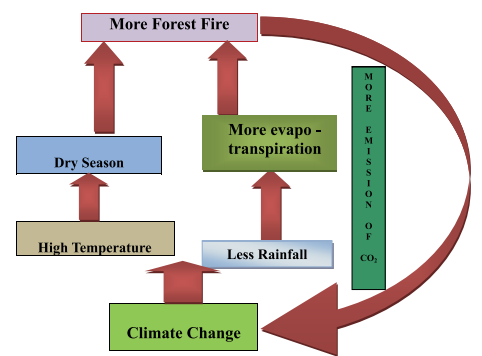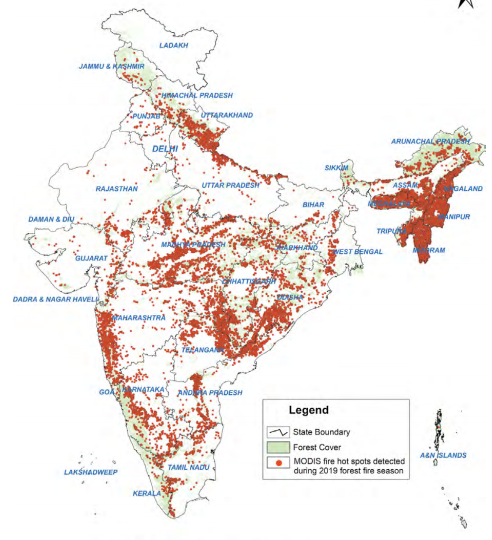India and Forest fires
2020 JAN 19
Mains >
Environment & Ecology > Degradation & Deforestation > Forest fires

WHY IN NEWS?
Australia is ravaged by forest fires that have been burning the countryside for several weeks. Also, in India forest fires are a major concern and threat to valuable forest ecosystem.
WHAT ARE THE FINDINGS?
- In India, as per the India State of Forest Report (ISFR) 2019 by Forest Survey of India (FSI), about 21.40% of forest cover in India is prone to fires, with forests in the north-eastern region and central India being the most vulnerable.
- The finding has emerged from a study carried out by the FSI along forest fire points identified across the country from 2004 to 2017.
- The seven States of the north-eastern region accounted for 10,210 fire alerts, which make up about one-third of alerts in the country. Despite being a small state, Mizoram recorded the highest number of fire alerts (2,795).

FOREST FIRE:
- Forest fires are a regular phenomenon in our country often observed during the fire season. Every year large areas of forests are affected by fires of varying intensity and extent.
- The Forest Survey of India monitors incidents of forest fires. Equipments like the Moderate Resolution Imaging Spectro-radiometer (MODIS) is used for detection of fires.
- India’s vulnerability:
- 54.40% of forests in India are exposed to occasional fires
- 7.49% to moderately frequent fires
- 2.40 % to high incidence levels
- 35.71% of forests have not yet been exposed to fires of any real significance
- Recent fires:
- Bandipur forest fire in 2019 destroyed more than 1000 hectares and also claimed the life of a forest guard.
- Theni forest fire in 2018 claimed over 16 lives.
- Uttarakhand forest fire in 2016 brought 4000 hectares of forest to ashes and claimed seven lives.
- In 2018 a report titled ‘Strengthening Forest Fire Management in India’, jointly prepared by the Ministry of Environment, Forest and Climate Change (MoEFCC) and the World Bank was released. The report puts financial loss at national level due to forest fires every year at Rs. 1,100 crore.
|
FOREST SURVEY OF INDIA:
- Forest Survey of India (FSI) is a premier national organization under the union Ministry of Environment and Forests responsible for assessment and monitoring of the forest resources of the country.
- Established in 1981, the Forest Survey of India succeeded the "Preinvestment Survey of Forest Resources" (PISFR), a project initiated by Government of India with the sponsorship of FAO and UNDP.
- Its major objectives include:
- Preparing State of Forest Report biennially
- Conduct inventory in forest and non-forest areas and develop database
- Function as a nodal agency for collection, compilation, storage and dissemination of spatial database on forest resources.
- Conduct training of forestry personnel
- Strengthen research & develop infrastructure
- It has developed a forest fire monitoring and alert system.
- It is also developing ‘e-Green Watch’, an integrated e-Governance Portal for Automation, Streamlining & Effective Management of Processes related to Plantation & Other Forestry Works.
|
TYPES OF FOREST FIRES:
- Surface fires: Surface fire is the most common forest fires that burn undergrowth and dead material along the floor of the forest. It is the type of fire that burns surface litter, other loose debris of the forest floor and small vegetation.
- Crown fires: These are the fires that burn the top of trees and spread rapidly by wind. They usually advance from top to down of trees or shrubs, more or less interdependent of surface fires. Since it is over the heads of ground force it is uncontrollable until it again drops to the ground, and since it is usually fast moving, it poses grave danger to the fire fighters.
- Firestorms: Among the forest fires, the fire spreading most rapidly is the firestorm, which is an intense fire over a large area. As the fire burns, heat rises and air rushes in, causing the fire to grow. More air makes the fire spin violently like a storm and starts smaller fires around it.
CAUSES:
- NATURAL CAUSES:
- Forest fires can be caused by natural events such as lightning and thunderstorms, heat waves, friction of rolling stones, rubbing of dry bamboo clumps and volcanic eruptions.
- The growth of invasive alien species aggravates forest fires. The vast plantations of eucalyptus, Acacia, Pine, Lantana camara and Prosopis juliflora are a major reason for the rise of forest fires along Western Ghats and Himalayan foothills.
- ANTHROPOGENIC CAUSES:
- More than 90% forest fires are caused by human beings, deliberately, due to negligence or just by accident.
- Deliberate or intentional causes:
- Shifting cultivation: the practice of slash-and-burn shifting cultivation is the leading cause of forest destruction. The most heavily affected areas by slash and burning methods are the North Eastern parts of India.
- To clear forest land: Due to population explosion, the demand for land for economic activities has been rising rapidly. To meet these needs, forests are often set on fire. The recent forest fires in Brazilian Amazon are an example of this.
- To get good fodder crop: Forest fires are also caused intentionally to meet the need of fodder for grazing cattle. A major portion of the grazing requirement is met from forest area by setting fires to produce new flushes of grass in the dry season.
- To get better flush for tendu leaves: In central India, tendu areas are leased for the collection of leaves on an annual basis; the purchasers are therefore reluctant to make long-term investments in crop improvement. As an alternative, Tendu leaves collectors set fires in the summer months to promote a better flush of leaves.
- For concealing illicit activities: Smugglers and poachers occasionally start forest fires to hide the stumps of illicit felling. The poachers often use forest fires to flush out wild animals, which occasionally spread across large areas.
- To reap vengeance: In some cases forests are set on fire by miscreants in order to settle scores with the forest department or its staff.
- Accidental or Unintentional causes:
- Collection of Non Timber Forest Produce (NTFP): To facilitate collection of NTFP the collectors ignite fire, which accidentally may spread in the forest, resulting into major fire. For eg: The main non-wood forest product that contributes to forest fire in India is the Mahua flower. Mahua pickers burn the dry leaves under the trees to get a clean patch of floor to facilitate flower collection. While the intention is only to clear a small patch beneath a single tree, these fires often spread out of control.
- Protecting crop from wildlife: Villagers residing in or near the forest many times light up fire in the forest to keep the wild animals away from their crop and cattle. Sometimes when this fire is not put out completely, it may result in a disastrous forest fire.
- Burning of crop residue: To clear residue, farmers occasionally set fire to their crop residue. Sometimes these fires spread to the adjacent areas resulting in forest fires.
- Carelessness from villagers, tourists and campers: Travelers, picnickers, nomadic grazers or villagers sometimes throw un-extinguished cigarettes, match sticks or campfires in the forest areas. When accompanied by winds, this may result in fires capable of destroying large swaths of forests.
- Sparks from electric lines and equipments: Many of India’s forests are traversed by electric lines of high voltages. Occasionally they spark, which acts as ember to forest fires.
IMPACT:
- Loss of life and livelihood:
- Forest fires cause serious threat to life of humans as well as animals. Tribes, campers and tourists are the most vulnerable section of people.
- In India, where approximately 65 million people are classified as tribal and directly depend upon collection of non-timber forest products for their livelihood, forest fire have serious socio economic impacts.
- For wildlife, besides loss of life, their migration patterns and animal habitats are disrupted by fire. It also results in increased events of man-animal conflict.
- Loss of valuable timber resources:
- Forest fires cause indispensable loss to timber and deteriorate its quality. Valuable timber species like Teak, Sal, Chir, Deodar, Sheesam, Rosewood etc. Timber quality is affected by scorching, leading to defective butt logs. Fungal infection may occur through the damaged tissues and cause rot.
- Impact on abiotic resources:
- Repeated burnings result into destruction of the ground flora, ultimately leading to site deterioration and thus changes in soil nutrient status and accelerated erosion.
- Fires create chemical and physical changes in upper layer of soil making it impervious and thus reduce water infiltration. The removal of litter also decreases water holding capacity of soil and most of the rainwater is washed away removing top fertile soil of the forest resulting into loss of soil fertility.
- Increase in floods:
- The soil of the fire affected area loses its water holding capacity and becomes vulnerable for erosion. When the precipitation follows a severe fire, the impact of the water is very high and substantial. This increase in soil erosion in turn reduces the water holding capacity of streams and rivers, thus creating severe floods.
- Microclimate change:
- Removal of litter and duff, opening of the canopy and darkening of the soil surface by residues can cause changes in temperatures of the area and thereby the microclimate. As a result the changed area becomes unhealthy for living.
- Global warming & Climate change:
- Trees act as carbon sinks when they absorb carbon dioxide from atmosphere and build up the same in the form of wood. Burning of the vegetation release hundreds of years of stored Carbon Dioxide (CO2) into the atmosphere, and thus results into permanent destruction of important sink of carbon dioxide.
- Green house gases released during the combustion of vegetations lead to an increased warming of the earth that is human induced global climate change.

- Deteriorates quality of environment:
- Small fires are beneficial for forests, as they replenish soil nutrients and foster new growth. However, large and repeated fires destroy the green cover irreversibly.
- Forest fires releases noxious gases such as carbon monoxide, methane hydrocarbons, nitric oxide and nitrous oxide, which causes respiratory troubles, acid rains, eutrophication of water bodies etc.
- Burning forests and grasslands add to already serious threat of global warming
- Impact of fires on forests lasts even after decades in the form of diseases, insect attacks, and watershed damages.
MEASURES TO STOP FOREST FIRES:
- The strategies to prevent and mitigate forest fire seeks to eliminate one or more components of the ‘Fire Triangle’ i.e. fuel, heat and oxygen.

- Preventive: Forest fires are usually seasonal. They usually start in the dry season. Hence, through adequate checks forest fires can be prevented. This can be done through:
- Mapping of potentially vulnerable areas and establishment of preventions and containment plans
- Creation of firefighting resources such as equipments, transportation, communication devices and trained manpower
- Awareness generation: People who rely on the forests for their livelihood and tourists who visit the forests should be made aware of the threat of forest fires. Clear guidelines must be given to people and vehicles that traverse through forests.
- Curative:
- Fire fighters use Helicopters, airplanes and ground-based personnel to spray fire retardant chemicals, or pump water to fight the blaze. This is very expensive and not widely practiced in India.
- Creation of fire line: A fire line is a line through a forest which has been cleared of all vegetation. Once the blaze has burnt out all combustibles in the affected compartment, it vanishes out and the neighbouring compartments are saved.
- Creation of counter fire: Firefighters create a second fire called counter fire. The counter fire rushes towards the wildfire, leaving a stretch of burnt ground. As soon as the two fires meet, the blaze is extinguished.
INDIAN INITIATIVES:
- Professional approach towards forest management:
- The Indian Forest Service was revived in 1966 to ensure coordinated professional management of Forests. The purpose of establishing this cadre of officers has been safety and protection of environment and taking care of national interest.
- The subject 'Forest' was transferred to the Concurrent List from the State List of the Constitution of India in 1976 to ensure uniform policy and management throughout the nation.
- A separate Ministry of Environment and Forest was created in the Union Government in 1985 and the Forest wing from the Ministry of Agriculture was transferred to the new ministry
- The Forest Conservation Act, 1980 was enacted. It provides that areas recorded as Forests in Government records cannot be transferred for non-forestry use without the prior approval of the Government of India.
- Intensification of Forest Management Scheme (IFMS):
- With a view to minimizing fire hazards and controlling forest fires a Centrally Sponsored Scheme “Integrated Forest Protection Scheme” was launched during the 10th plan period. In 2009, the Integrated Forest protection Scheme (IFPS) has been revised and renamed “Intensification of Forest Management Scheme” (IFMS).
- The components of the scheme includes:
- Forest fire control and management
- Survey, demarcation and preparation of working plans,
- Strengthening of infrastructure such as roads, camp offices, watch towers,
- Improved mobility, providing fire arms and use of modern information and communication technology.
- National Action Plan On Forest Fires, 2018
- The plan also aims to reduce the vulnerability of forests against fire hazards across the diverse forest ecosystems in the country, enhancing the capabilities of institutions in fighting fires, and accelerating the recovery after a fire incidence.
- One of the main objectives of the action plan is to reduce the incidences of fires by informing, enabling and empowering forest fringe communities and incentivizing them to work in tandem with the State Forest Departments (SFDs).
- The plan proposes nine strategies to address the issue, including establishment of a “Centre of Excellence on Forest Fire Management” at FSI. The National Action Plan also acknowledges the role of FSI in providing timely forest fire alerts to the SFDs and Communities
- Initiatives of Forest Survey of India:
- Near Real Time (NRT) Forest Fire alerts: FSI alerts State Forest Departments of forest fire locations detected by the MODIS sensor on-board Aqua and Terra Satellites of NASA.
- Forest Fire Pre warning alerts: FSI using its repository of fire related data has developed an indigenous “Pre Warning Alert System”. The alerts to State Forest departments are based on parameters like Forest Cover, Forest Type, Climatic Variables (Temperature and Rainfall) and recent fire incidences over the area.
- Forest Fire Alerts System (Fast 3.0): A new version of FSI Forest Fire Alerts System was launched in 2019 by adding several new features to the earlier version. A major improvement over the previous version is the addition of large forest fire monitoring which identifies and tracks large fires in an automated manner.

Fig a: Map showing MODIS hot spots detected during 2018-19 forest fire season
WAY FORWARD:
- India has set ambitious policy goals to meet its INDC commitments under the Paris deal. A large share of its carbon sink for this is planned to be created through improving the quality and quantity of its forests. However, The World Bank has pointed out that forest fires pose a serious threat to India’s ability to expand its forest and tree cover by 2030.
- Uncontrolled fires are a complex problem that requires a comprehensive and long term policy. It demands proper co-ordination mechanisms between the community, state governments, the forest departments, National Disaster Management Authority and the MoEF&CC. Hence the government should come up with a national policy on forest fires. In fact, the National Green Tribunal has repeatedly asked the MoEF&CC to come out with a national policy on forest fires.
- The NDMA should be given a greater role in the management of forest fires. Since forest fires are not typically treated as disasters, the disaster management authorities have so far played a minor role in this matter. Hence, forest fires should be treated as disasters so that disaster management authorities can play a major role in planning and managing them.
- Community participation is vital for the success of any disaster management strategy. Hence in case of forest fire management, the active participation of people, especially the tribal communities needs to be ensured. For the same, initiative like joint forest management and social forestry can be encouraged.
- In a climate uncertain future, India’s vulnerability towards forest fires is expected to rise in the coming years. Considering its socioeconomic impact on the country, tackling forest fires is of prime important.
|
INDIA STATE OF FOREST REPORT 2019:
Every two years, Forest Survey of India (FSI) undertakes assessment of country’s forest resources, the results of which are presented as the ‘India State of Forest Report (ISFR)’. The key findings of the ISFR 2019 are:
- The total Forest and Tree cover of the country is 8,07,276 sq km which is 24.56% of the geographical area of the country.
- The total forest cover of the country is 7,12,249 sq km which is 21.67% of the geographical area of the country.
- The tree cover of the country is estimated as 95,027 sq km which is 2.89% of the geographical area
- The top five States in terms of increase in forest cover are Karnataka (1,025 sq km), Andhra Pradesh (990 sq km), Kerala (823 sq km), Jammu & Kashmir (371 sq km) and Himachal Pradesh (334 sq km).
- Total forest cover in the North Eastern region is 65.05% of its geographical area. The current assessment shows a decrease of forest cover to the extent of 765 sq km (0.45%) in the region. Except Assam and Tripura, all the States in the region show decrease in forest cover.
- Mangrove cover in the country has increased by 54 sq km (1.10%) as compared to the previous assessment
- There is an increase of 42.6 million tonnes in the carbon stock of the country as compared to the last assessment of 2017.

|
Practice Question
Q. Incidents of forest fire have been on the rise in India. Discuss the causes of forest fires. What measures can be taken to prevent forest fires




